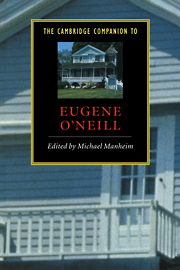Book contents
- Frontmatter
- Introduction
- 1 Celebrant of loss: Eugene O'Neill 1888-1953
- 2 O'Neill's philosophical and literary paragons
- 3 O'Neill and the theatre of his time
- 4 From trial to triumph: the early plays
- 5 The middle plays
- 6 The late plays
- 7 Notable American stage productions
- 8 O'Neill on screen
- 9 O'Neill's America: the strange interlude between the wars
- 10 O'Neill's African and Irish-Americans: stereotypes or “faithful realism”?
- 11 O'Neill's female characters
- 12 "A tale of possessors self-dispossessed"
- 13 Trying to write the family play: autobiography and the dramatic imagination
- 14 The stature of Long Day's Journey Into Night
- 15 O'Neill and the cult of sincerity
- 16 O'Neill criticism
- Select bibliography of full-length works
- Index
16 - O'Neill criticism
Published online by Cambridge University Press: 28 May 2006
- Frontmatter
- Introduction
- 1 Celebrant of loss: Eugene O'Neill 1888-1953
- 2 O'Neill's philosophical and literary paragons
- 3 O'Neill and the theatre of his time
- 4 From trial to triumph: the early plays
- 5 The middle plays
- 6 The late plays
- 7 Notable American stage productions
- 8 O'Neill on screen
- 9 O'Neill's America: the strange interlude between the wars
- 10 O'Neill's African and Irish-Americans: stereotypes or “faithful realism”?
- 11 O'Neill's female characters
- 12 "A tale of possessors self-dispossessed"
- 13 Trying to write the family play: autobiography and the dramatic imagination
- 14 The stature of Long Day's Journey Into Night
- 15 O'Neill and the cult of sincerity
- 16 O'Neill criticism
- Select bibliography of full-length works
- Index
Summary
O'Neill criticism falls essentially into two categories: (I) the reception of his plays in critical reviews following their performances, and (2) the interpretation and evaluation of his plays by scholars and historians. The former have obviously appeared in newspapers like the New York Times and magazines like Time, Newsweek, The Nation, and The New Yorker; the latter in scholarly journals and in books devoted to his life and works. From the early 1920s until the late 1930s - the period of O'Neill's heyday as a popular dramatist - journalistic reviews were the chief category, though some quasi-scholarly studies also appeared in that period, most notably Barrett H. Clark's Eugene O'Neill, which was originally published in 1926. With the appearance of Sophus Winther's O'Neill: A Critical Study in 1934, evaluation of the playwright as a (if not the) major American dramatist and a significant figure in world drama has come to predominate, though obviously reviews of individual productions in the United States and, increasingly, abroad continue to appear.
- Type
- Chapter
- Information
- The Cambridge Companion to Eugene O'Neill , pp. 236 - 243Publisher: Cambridge University PressPrint publication year: 1998
- 1
- Cited by

